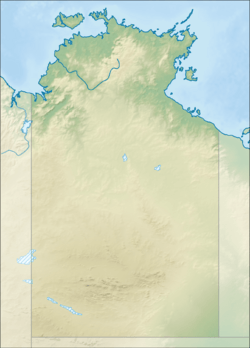Lake Mary Ann facts for kids
Quick facts for kids Lake Mary Ann |
|
|---|---|

Lake Mary Ann
|
|
| Location | Warumunga, Northern Territory |
| Coordinates | 19°36′36″S 134°12′42″E / 19.61°S 134.2117°E |
| Type | reservoir |
| Basin countries | Australia |
Lake Mary Ann, also known as Tingkkarli, is a special place near Tennant Creek, Northern Territory. It's about 5 kilometres (3.1 mi) (3 miles) north of the town, right off the Stuart Highway.
This lake is actually a man-made dam. It's a great spot for fun water activities like swimming and canoeing. One side has nice grassy areas, perfect for picnics. The other side is natural bushland, full of local plants and animals.
History of Lake Mary Ann
The Waramungu people are the traditional owners of the land around Tingkkarli. They have lived in this area for thousands of years.
After European settlement, the land was marked for mining. In the early days, miners Nugget Wilson, Bill Howes, and Harold Williams claimed a mining area here. Wilson and Howes named their mine 'Mary Ann'. They chose this name to honor their daughters, Mary Jean and Wendy Ann. Because of this, the nearby stream became known as Mary Ann Creek.
Building the Dam
People first thought about building a dam here in the late 1940s. They wanted to increase the water supply for Tennant Creek and the Peko Mine. The idea came up again in the mid-1950s.
In 1977, people living in the area suggested building a dam for recreation. They wanted a place where everyone could enjoy water sports. The Northern Territory Government liked this idea. Construction of the dam started in 1979 and finished in 1980.
The dam was officially opened on April 24, 1981. The Honorable Ian Tuxworth, a local politician, opened it. It was first called the Mary Ann Dam.
Native Title Recognition
In 2014, an important decision was made about the land around Lake Mary Ann. The Federal Court recognized the native title claims of the Waramungu people. This means the court agreed that the Waramungu people have traditional rights and interests in this land. This decision covered a huge area of 37,000 square kilometers.


